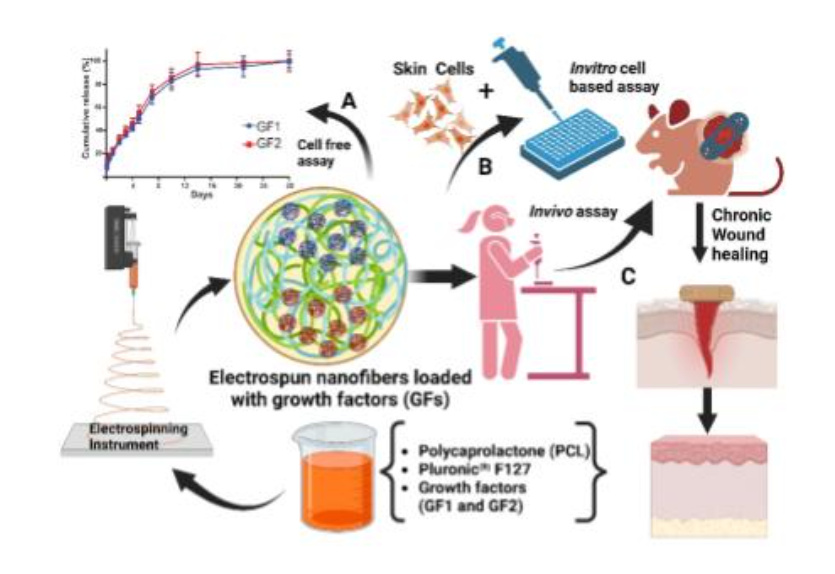Description:
The nanofibers are loaded with a pair of growth factors that promote efficient wound healing through sustained activation of select pathways
Background
An average of 2% of the total United States population have chronic wounds, but current treatments are inadequate. We’re developing new ways to heal chronic wounds by using electrospun nanofibers loaded with specific growth factors. Electrospun nanofibers structurally and functionally resemble extracellular matrix, and when loaded with wound healing factors, are a promising form of wound dressing to promote better healing.
Technology Description
This research collaboration and licensing opportunity is for nanofibers that promote the healing of chronic wounds. The nanofibers are loaded with a pair of growth factors that promote efficient wound healing through sustained activation of MAPK, AKT, and MET pathways.
In order to determine specific growth factors useful for enhancing wound healing, the inventors first identified a cohort of growth factors altered in a mouse model of delayed wound healing (Bcl11bep-/-). The two principal growth factors were identified based on relative fold change and significant downregulation in the wound healing model. Subsequently, the inventors incorporated the growth factors into polycaprolactone nanofibers and demonstrated improved healing outcomes in a mouse model of delayed would healing (Bcl11bep-/- mice; splinted model).

Figure 1: Schematic representation of generation and validation of growth factors (GFs) loaded nanofibers
Electrospun nanofiber made up of Polycaprolactone and Pluronic® F127 was loaded with growth factors GF1 and GF2. The nanofibers loaded with GFs used in (A) cell free assay indicated their sustained release over an extended period of time, (B) in vitro cell based assay enhanced proliferation and migration, (C) in vivo assay using a mouse model of delayed and chronic wound healing accelerated and promoted efficient wound closure.
The next steps for translating this promising technology from bench to bedside will be the use of these factors for testing out in the porcine model of diabetic wounds to elucidate the mechanisms of action.
Features & Benefits
- Supplementation of growth factors specifically reduced in delayed wound healing
- Sustained release over the time course of healing promotes more complete healing
- Synergism of growth factors activates multiple wound healing pathways
Applications
- Chronic wounds
- Diabetic wounds
- Diabetic foot ulcers
- Pressure ulcers
Opportunity
Oregon State University is seeking a license or research sponsor interested in developing and taking to market growth factor loaded nanofibers envisioned by this technology and covered by the pending patent rights. As part of a research collaboration, they also seek to make next generation nanofibers that are more efficient and biodegradable that meet the need for treatment of chronic, non-healing wounds. The University of Nebraska is a co-owner of the filed U.S. provisional patent application. Previous patent applications related to the nanofibers were filed by one of the co-inventors, Dr. Jingwei Xie, and are owned by the University of Nebraska. Dr. Xie and University of Nebraska continue to explore which factors are best in nanofiber-based wound dressings for sustained therapeutic delivery to achieve enhanced wound healing.
Status
Patent application submitted